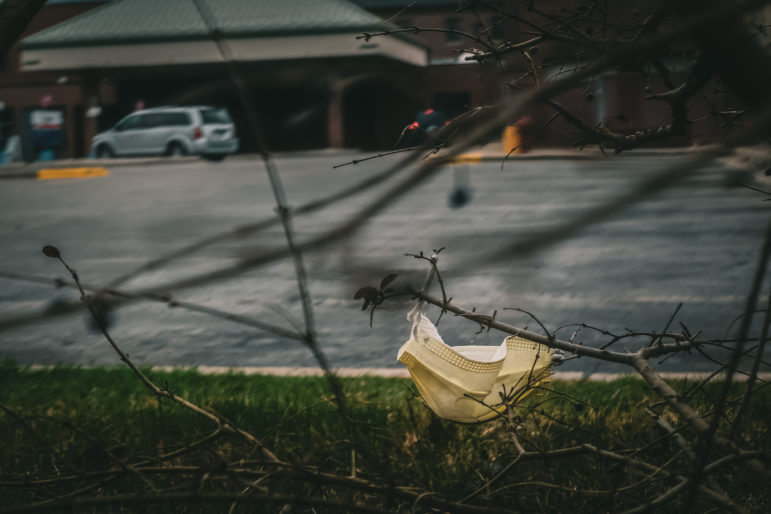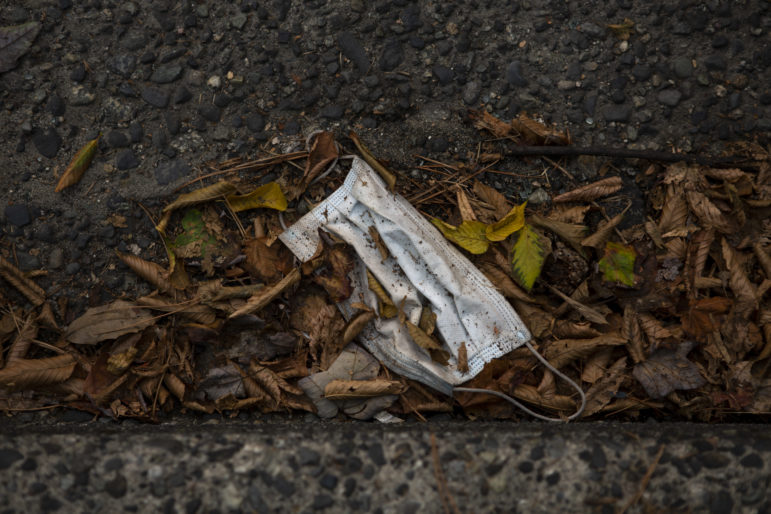TWH – Most protective face masks are single-use items with high plastic content. Life-saving face-masks can become life-threatening plastic litter if disposed of improperly. Public health officials had to develop, on the fly with minimal information, COVID containment strategies. Those strategies relied on face masks and other personal protective equipment (PPE). That reliance increased the production and use of PPE. In their rush to save lives, public health officials failed to develop strategies to manage the predictable increase in used PPE.
What exactly is PPE?
Among all PPE, non-medical people have the greatest familiarity with face masks. Other types of PPE include face shields, gloves, medical gowns, and disinfecting wipes.
In 2022, the “Journal of Hazardous Materials” reported that most PPE contains either plastic or its derivatives. PPE has high “percentages of polypropylene (PP) and polyethylene (PE). They also contained other polymeric materials such as polyester, polyurethane, nylon, and polystyrene.” Still, PPE has played and will continue to play, a vital role in disease prevention.
How substantial a problem is PPE litter?
The COVID pandemic has led to a massive increase in the production and use of single-use PPE.
For the last two years, everyone on the planet should have been wearing some type of face mask. This increased use of single-use face-masks would add significantly to plastic pollution. In urban areas, it is common to see facemasks discarded in street gutters. Used PPE had become PPE litter.
The “Journal of Hazardous Materials” reported on surveys of PPE litter in coastal communities. It attributed the large amount of PPE litter to “poor waste management practices and a lack of environmental awareness among locals and beachgoers.”
The world market for personal protective equipment
By 2020, China had increased its production of single-use face masks to 200 million per day.
The journal “Nature Sustainability” reported that between 2019 and 2020, the value of the global market for PPE had increased from 800 million to $166 billion in U.S. dollars.
Plastic can last for 100s of years. It does, however, slowly degrade into fibers, fragments, and small pieces. Those small pieces, less than five millimeters (0.2 inches), are called microplastics. Nature can never absorb those microplastics.
The journal, “Environmental Technology & Innovation” reported that the wind can easily carry those microplastics. They can be swept into the sewer systems. In water, PPE litter floats.
PPE litter, a global problem
Researchers have found PPE litter in Australia, Belgium, France, Germany, the Netherlands, New Zealand, Spain, Sweden, the United Kingdom, and the United States. Researchers also found PPE litter in “streets nearby beaches and metropolitan areas (Canada and South Africa), river outlets (Indonesia), and coastal shorelines (Peru, Chile, Bangladesh, Persian Gulf, and Morocco).”

Discarded masks in a trash bin, Winschoten, Oldambt – Image credit: Donald Trung Quoc Don (Chữ Hán: 徵國單) – CC BY-SA 4.0
Fortunately, citizen-scientists had been collecting data on litter since September 2019. They collected pre-pandemic and pandemic data. Those data sets allowed scientists to check differences in PPE litter among all litter. The data gathering occurred in only 11 developed, western nations. In these surveys, citizen-scientists found three types of PPE: face masks, gloves, and wipes.
Prior to the current pandemic, researchers found that the proportion of masks among all litter was less than 0.01% and approximately 0.02% for gloves and wipes. The percentage of masks increased from less than 0.01%, pre-pandemic, to 0.84% by October 2020. The presence of gloves increased from roughly 0.02% pre-pandemic to a peak of 2.4% but then declined to about 0.04% by October 2020. The number of wipes among litter showed a pattern similar to that of gloves.
The timing of these patterns reflects the preventive advisories that the World Health Organization (WHO) and other authorities had issued. Gloves and wipes showed an increase, a peak, and then a decline, and likely reflects changes in understanding COVID-19’s transmissibility via touch.
Differences existed among the 11 developed and western countries. By October 2020, the United Kingdom, had the highest proportions of PPE litter among all litter. From August to October 2020, face masks constituted more than 5% of all litter in the U.K. Gloves and wipes made up about 1.5% of all litter in the U.K. In the Netherlands, the proportions were much lower. None of the three types of PPE exceeded 1% of all litter. In Sweden, no one had found any litter for several months.
Government and WHO policy changes, at the macro level, and individual fear, at the micro-level, drove the increase in PPE use. Those policy changes failed to include an effective waste management strategy for PPE.
What are the risks of PPE litter to individuals?
Woven masks release fewer microplastics than surgical masks. The latter have a middle layer of melt-blown fabric. That inner layer releases more microplastics than either outer layer.
People can breathe in or ingest wind-borne microplastics. People risk ingesting microplastics when they eat the flesh of creatures that have ingested microplastics.
What are the risks of PPE litter to ecosystems?
Ingested microplastics can accumulate. At a certain point, the plastic in an organ can become so dense, that the organ can no longer function. Animals, fish, and birds can also become entangled in larger plastic objects, like the ear loop of a face mask.

Discarded mask – McLaren Central Michigan – Image credit: Dan Gaken (Mt. Pleasant, MI) – CC BY 2.0
To date, scientists have only linked one animal death to PPE litter. A juvenile Magellanic penguin had eaten a discarded face mask. PPE litter, however, has only begun its centuries-long degradation process. As PPE litter continues to degrade is likely that more animals, fish, and birds may die.
What, if any, are the alternatives?
The authors of the “Nature Sustainability” article argued for increased policy attention to the disposal of PPE. They suggested the creation of waste bins specifically for used PPE. They also advocated increasing street cleaning and suggested advertising campaigns designed to discourage littering of PPE.
If someone puts a discarded face mask into their home trash, it’s better than leaving it on the street. It could still, however, end up in a landfill, threatening ecosystems.
One obvious solution would be reusable PPE. Few such PPE exist. Only washable medical gowns can function as disease barriers.
Except for face shields and less effective cloth masks, all face masks are single-use products. The CDC has reported that “Face shields alone are not recommended for source control” of COVID-19.
Face masks have been an invaluable tool in containing COVID-19. Still, face masks in gutters and landfills pose a serious threat to public health in themselves. This problem follows a long line of other waste management failures.
The Wild Hunt is not responsible for links to external content.
To join a conversation on this post:
Visit our The Wild Hunt subreddit! Point your favorite browser to https://www.reddit.com/r/The_Wild_Hunt_News/, then click “JOIN”. Make sure to click the bell, too, to be notified of new articles posted to our subreddit.
